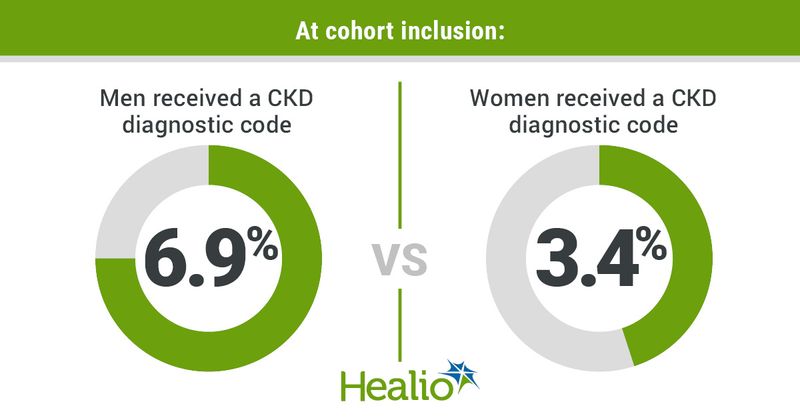Women less likely to receive CKD diagnostic code, referral, recommended medication
The detection, recognition, monitoring, referrals and management of chronic kidney disease significantly differs between men and women, according to data published in Journal of the American Society of Nephrology.
Further, women were far less likely to receive a CKD diagnostic code or proper care compared with men.

“CKD is prevalent, affecting 8 to 16% of adults worldwide (11.8% of all women, 10.4% of all men), conferring large [health care] costs, and contributing to excess comorbidity and death,” Oskar Swartling, MD, from the clinical epidemiology division in the department of medicine at Karolinska Institute in Sweden, and colleagues wrote. They added, “While most people with CKD are identified, followed and managed in the primary care setting, evidence on differences by sex or gender derive mostly from the minority of patients referred to nephrology specialist units.”
In a health care-based study, researchers assessed differences in the recognition, detection, monitoring and management of CKD between men and women. The study consisted of 227,847 adults (55% women) with at least one outpatient eGFR less than 60 mL/min/1.732 indicating possible CKD between 2009 and 2017. All data were derived from the Stockholm Creatinine Measurements (SCREAM) project.
Researchers determined odds ratios for having received a CKD diagnosis and provision of renin-angiotensin inhibitors (RASi) and statins at inclusion. Additionally, they calculated hazard ratios for receiving a CKD diagnosis, visiting a nephrologist or monitoring of creatinine and albuminuria during follow-up.
Compared with men, women were less likely to receive a diagnostic code for CKD (6.9% of men vs. 3.4% of women) and receive RASi and statins at inclusion. Time-to-event analyses revealed women were less likely to receive a CKD diagnosis and visit a nephrologist despite disease severity, presence of albuminuria or a referral. Similarly, women had lower odds of undergoing monitoring of creatinine or albuminuria, including those with diabetes or hypertension.
Researchers noted that the differences remained among those with confirmed CKD at retesting after adjusting for comorbidities, albuminuria and highest educational achievement.
“[...] we observed profound sex differences in detection, recognition and monitoring that persisted over time: women were less likely to receive a CKD diagnosis, to visit a nephrologist, to have their creatinine and albuminuria measured or to receive guideline-recommended therapies,” Swartling and colleagues wrote.
In a press release, co-author Juan J. Carrero, Pharm, PhD, added, “We were expecting to find small or no disparities in how men and women were managed, because guidelines do not make distinctions by sex. Instead, we observed profound differences in the detection work up and management of chronic kidney disease suggesting suboptimal care among women. Surprisingly, these differences were observed across high-risk groups and indications, such as women with diabetes, macroalbuminuria or advanced chronic kidney disease.”
Reference:
Analysis reveals sex differences in the recognition, monitoring, and treatment of chronic kidney disease. https://www.newswise.com/articles/analysis-reveals-sex-differences-in-the-recognition-monitoring-and-treatment-of-chronic-kidney-disease?sc=dwhr&xy=10007438. Published July 29, 2022. Accessed July 29, 2022.
